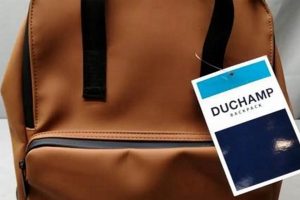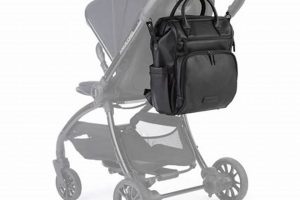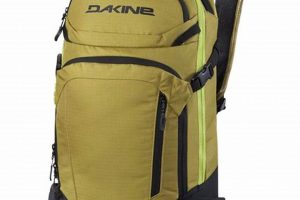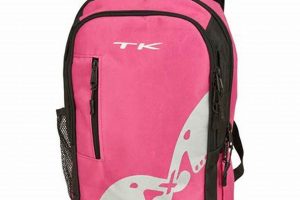An accessory frequently seen amongst students and those with an interest in self-expression, this item is a type of bag, typically worn on the back, designed with a surface that accommodates the affixing of decorative items. These items, often metallic or enamel, are attached to the bag, showcasing individual interests, affiliations, or artistic expression. For example, a student might adorn their bag with items representing their favorite bands, hobbies, or social causes.
The appeal of these customized bags lies in their ability to transform a functional object into a personal statement. They provide a portable and visually engaging way to display individuality. Historically, the practice of customizing bags has roots in counter-culture movements, where clothing and accessories were used to express dissent or solidarity. Today, it’s more mainstream, appealing to a wide range of demographics who seek a unique avenue for self-representation.
The subsequent sections of this article will delve into the various types of these bags, the techniques for securely attaching these decorative items, and the best practices for maintaining and showcasing a collection. Furthermore, advice on sourcing unique and collectible decorative attachments will be provided.
Tips for Optimizing a Pin Backpack
The following guidelines offer strategies for maximizing the aesthetic appeal, durability, and practical use of a bag designed for pin display.
Tip 1: Choose a Durable Base Material: Opt for a backpack constructed from robust materials like canvas, nylon, or reinforced polyester. These fabrics withstand the repeated piercing and removal of pin backs, minimizing wear and tear.
Tip 2: Reinforce Attachment Points: Consider reinforcing the fabric at pin attachment points with fusible interfacing or small patches of sturdy fabric. This provides added support and prevents holes from enlarging over time.
Tip 3: Utilize Locking Pin Backs: Standard pin backs can easily detach. Invest in locking pin backs, which provide a more secure hold and reduce the risk of losing valuable or sentimental items.
Tip 4: Strategically Arrange Pins: Plan the placement of pins to create a visually balanced and aesthetically pleasing display. Consider themes, color palettes, and spacing to achieve the desired effect.
Tip 5: Protect Pins from the Elements: Exposure to moisture can damage enamel and cause metal to tarnish. Apply a sealant or protective coating to pins to shield them from the elements.
Tip 6: Regularly Inspect and Maintain: Periodically inspect the bag and pins for loose backs, damaged fabric, or signs of wear. Promptly address any issues to prevent further damage or loss.
Tip 7: Consider Display Inserts: Implement a display insert to add dimension and layering to the pin arrangements. Foam inserts or pre-designed pin displays can elevate the presentation.
By implementing these measures, individuals can safeguard their collections, enhance the longevity of the backpack, and present a polished and personalized display of their interests and affiliations.
The subsequent section will explore the ethical considerations surrounding the acquisition and display of pins, fostering responsible collecting practices.
1. Material Durability
The material from which a “pin backpack” is constructed is paramount to its longevity and functionality. The repetitive action of inserting and removing pin backs places considerable stress on the fabric. Inferior materials are prone to tearing, stretching, and weakening around the pin attachment points, ultimately compromising the structural integrity of the bag. A poorly constructed backpack necessitates frequent repairs or replacement, resulting in increased expense and inconvenience. For example, a backpack made of thin canvas will quickly develop visible holes and fraying, leading to pin loss and rendering the bag unusable.
Conversely, backpacks crafted from durable materials such as ballistic nylon, heavy-duty canvas, or reinforced polyester exhibit superior resistance to wear and tear. These materials can withstand the constant pressure exerted by pin backs, maintaining their form and structural integrity over extended periods. Furthermore, the density of the weave in durable materials provides a more secure grip for pin backs, reducing the likelihood of pins detaching unexpectedly. Backpacks designed for frequent use and heavy pin displays benefit significantly from the incorporation of these robust materials. These can withstand the challenges of day-to-day use. This ensures the collection remains safely and securely displayed.
Therefore, material durability is not merely a superficial attribute but a fundamental requirement for any “pin backpack.” Investing in a backpack constructed from high-quality, durable materials ensures its longevity, protects the valuable pin collection, and provides a reliable and functional accessory. While initial cost may be higher, the long-term benefits of enhanced durability outweigh the expense, making it a crucial consideration for discerning consumers.
2. Attachment Security
Attachment security is a critical element in the design and functionality of a “pin backpack.” It directly impacts the preservation of the decorative items affixed to the bag and the overall value of the personalized expression it represents. Secure attachment minimizes the risk of loss, damage, or theft of pins, thereby safeguarding the investment and sentimental value associated with the collection.
- Pin Back Mechanisms
The type of pin back mechanism employed is a primary factor influencing attachment security. Standard butterfly clutch backs are commonly used but are susceptible to accidental release due to friction or pressure. Locking pin backs, featuring mechanisms that physically secure the pin in place, offer a more robust solution. Furthermore, magnetic clasps provide an alternative, although their holding power may vary depending on the strength of the magnet and the weight of the pin. The choice of pin back should align with the value and significance of the attached item.
- Fabric Integrity and Reinforcement
The integrity of the backpack fabric at the point of pin insertion is crucial for maintaining a secure hold. Thin or loosely woven fabrics are prone to tearing and stretching, compromising the grip of the pin back. Reinforcing the fabric with interfacing, patches, or grommets strengthens the attachment point, preventing the pin from loosening or falling out. Consider the density and durability of the fabric when selecting a “pin backpack” to ensure long-term attachment security.
- Regular Inspection and Maintenance
Even with secure pin back mechanisms and reinforced fabric, regular inspection and maintenance are essential. Pin backs can loosen over time due to vibration, movement, or wear. Periodically checking the tightness of pin backs and reinforcing them as needed prevents accidental loss. Furthermore, inspecting the fabric for signs of wear or damage and addressing any issues promptly maintains the structural integrity of the attachment points.
- Pin Placement and Weight Distribution
Strategic pin placement and balanced weight distribution contribute to attachment security. Overcrowding pins or concentrating weight in a single area can strain the fabric and increase the risk of pins detaching. Distributing the weight evenly and avoiding placing pins too close together reduces stress on individual attachment points and enhances overall security.
In conclusion, attachment security is not merely a desirable feature but a fundamental requirement for a “pin backpack.” A combination of robust pin back mechanisms, reinforced fabric, regular maintenance, and strategic pin placement ensures the preservation of the pin collection and maximizes the lifespan of the backpack. Neglecting these factors can result in the loss of valuable and sentimental items, diminishing the bag’s intended purpose as a personalized expression of identity and interests.
3. Personal Expression
The “pin backpack” serves as a tangible medium for individual expression, allowing the owner to curate a visual representation of their interests, affiliations, and beliefs. The act of selecting and arranging decorative items transforms a functional object into a personalized statement, communicating aspects of the individual’s identity to the external world.
- Affiliation and Identity
Pins frequently denote membership or support for specific groups, organizations, or causes. The display of such pins on a backpack communicates the individual’s alignment with these entities, signaling shared values and fostering a sense of belonging. For instance, displaying pins representing musical bands, political movements, or academic clubs indicates the individual’s engagement with those communities and their associated ideologies.
- Interests and Hobbies
Pins can visually articulate the individual’s passions and pastimes. A backpack adorned with pins depicting video game characters, artistic motifs, or sports logos communicates the owner’s engagement with these activities and their associated subcultures. This serves as an immediate visual cue to others who share similar interests, facilitating connection and conversation.
- Artistic and Aesthetic Preferences
The selection of pins based on their visual appeal allows for the expression of individual artistic sensibilities. The arrangement of pins, their color schemes, and their overall aesthetic impact contribute to the backpack’s unique visual identity. This form of expression transcends mere labeling of interests; it reflects the individual’s taste, creativity, and ability to curate a visually coherent and compelling display.
- Symbolic and Sentimental Value
Beyond overt representation, pins can hold personal significance, representing memories, experiences, or relationships. A pin acquired during a specific event, a gift from a loved one, or a symbol representing a personal milestone transforms the backpack into a repository of individual history and emotion. These pins serve as tangible reminders of significant moments and relationships, adding depth and meaning to the backpack’s visual narrative.
The convergence of these facets transforms a simple backpack into a dynamic canvas for self-representation. The careful selection and arrangement of pins allows for a nuanced and evolving articulation of identity, interests, and values. The “pin backpack” thus becomes more than a functional accessory; it is a portable and personalized expression of the individual’s inner world.
4. Weight Distribution
The concept of weight distribution is particularly relevant in the context of a “pin backpack” due to the potential for uneven loading resulting from the placement of decorative items. Unlike standard backpacks where weight is generally distributed evenly across the compartments, the addition of numerous pins to a specific area can create concentrated weight zones. This uneven distribution impacts comfort, potentially leading to muscle strain, particularly in the shoulders and back. For instance, a backpack with a substantial number of pins clustered on one shoulder strap will likely cause discomfort and postural imbalance over prolonged periods of wear. Therefore, understanding and addressing weight distribution is a fundamental component of optimizing the functionality and user experience of this accessory.
Practical application of this understanding involves several key strategies. The initial step entails selecting a backpack with padded and adjustable shoulder straps, allowing for customization to fit the wearer’s body and mitigate the effects of uneven weight. Furthermore, strategic pin placement becomes crucial. Distributing pins across a wider surface area, rather than concentrating them in one location, diffuses the load and reduces the likelihood of localized strain. For example, alternating heavier metal pins with lighter enamel ones can also contribute to a more balanced load. The internal organization of the backpack should also be considered, placing heavier items in the compartment closest to the wearer’s back to improve stability and reduce strain.
In summary, weight distribution is an essential factor in the usability and comfort of a “pin backpack.” Addressing potential imbalances through careful selection of the backpack itself, thoughtful pin placement, and strategic internal organization minimizes the risk of physical strain and enhances the overall wearing experience. Ignoring this aspect can lead to discomfort and potential health issues, underscoring the practical significance of this understanding for both manufacturers and users. The challenge lies in balancing aesthetic expression with ergonomic considerations, ensuring that the personalized nature of the “pin backpack” does not compromise its functionality and wearer well-being.
5. Organization
Effective organization is paramount to the functionality and aesthetic appeal of a “pin backpack.” The deliberate arrangement of pins, coupled with the internal structuring of the backpack itself, influences accessibility, display quality, and the prevention of damage. Disorganized pin displays risk obscuring individual items, diminishing their visual impact, and increasing the likelihood of pins snagging on external objects. Furthermore, a poorly organized backpack interior complicates the retrieval of essential items, detracting from its practical utility. For example, a student carrying textbooks, stationery, and electronic devices alongside a collection of haphazardly arranged pins will likely experience difficulty locating specific items and risk damaging both the pins and the backpack’s contents.
The relationship between “organization” and the “pin backpack” manifests in two primary domains: external display and internal storage. Externally, a thematic or chronological arrangement of pins can enhance the visual narrative and communicative potential of the display. For instance, a collection of pins related to a specific fandom might be organized by character, episode, or theme, creating a cohesive and visually engaging composition. Internally, the strategic placement of compartments and pockets within the backpack allows for the segregation and protection of different types of items. Dedicated sleeves for laptops, padded compartments for fragile items, and zippered pockets for small accessories contribute to an efficient and secure storage system. An individual traveling with a “pin backpack” containing both electronic devices and a valuable pin collection benefits from the organized storage. This reduces the risk of scratches or breakages, demonstrating the tangible advantages of thoughtful interior design.
In conclusion, organization is not merely an aesthetic consideration but a critical element in the overall functionality and value of a “pin backpack.” By prioritizing both the arrangement of external pin displays and the internal structuring of storage compartments, users can maximize accessibility, minimize damage, and enhance the backpack’s utility as a personalized and practical accessory. The challenge lies in balancing the desire for self-expression with the need for efficient organization, ultimately contributing to a more seamless and enjoyable user experience. This approach transforms the “pin backpack” from a simple carrier into a curated showcase of individual identity and practical organization.
Frequently Asked Questions
This section addresses common inquiries regarding the characteristics, care, and usage of a specific type of bag designed to accommodate decorative attachments.
Question 1: What materials are best suited for a “pin backpack” to ensure durability?
Backpacks intended for significant pin displays benefit from robust materials. Ballistic nylon, heavy-duty canvas, and reinforced polyester offer increased resistance to tearing and wear around pin attachment points.
Question 2: How can pin attachments be secured to minimize the risk of loss?
Employing locking pin backs, as opposed to standard butterfly clutches, significantly reduces the likelihood of accidental detachment. Reinforcing the fabric at attachment points further enhances security.
Question 3: Is there a recommended method for cleaning a “pin backpack” without damaging the pins?
Spot cleaning with a damp cloth is generally advisable. Immersing the backpack in water could damage certain pin materials or cause corrosion. Consider removing pins before attempting a more thorough cleaning, if necessary.
Question 4: Can a “pin backpack” be effectively used for carrying heavy items such as textbooks or laptops?
The bag’s suitability for heavy items depends on its construction and design. Ensure the backpack features reinforced seams, padded shoulder straps, and a dedicated laptop compartment, if applicable. Distribute weight evenly to minimize strain.
Question 5: What are some ethical considerations when acquiring pins for a “pin backpack”?
Prioritize purchasing pins from reputable sources to avoid supporting counterfeit or unlicensed merchandise. Consider the origins of materials used in pin production and the labor practices of manufacturers.
Question 6: How does the weight of pins affect the overall comfort and usability of a “pin backpack”?
Accumulated pin weight can contribute to discomfort and postural strain, particularly with uneven weight distribution. Choose lighter-weight pins when possible and strategically arrange the display to distribute weight evenly across the backpack’s surface.
Proper material selection, attachment security, and responsible acquisition practices are vital in maximizing the value. Attention to weight distribution and appropriate cleaning methods helps ensure the longevity and functionality of this personalized accessory.
The subsequent section provides a glossary of common terms and definitions associated with.
Conclusion
This exploration of the “pin backpack” has illuminated its multifaceted nature, extending beyond a simple carrying accessory. It functions as a canvas for personal expression, a vehicle for conveying affiliations, and a statement of individual identity. Key considerations, as examined throughout this article, include material durability, attachment security, weight distribution, and organizational efficiency. Attention to these factors ensures that the “pin backpack” effectively fulfills its dual role as a functional object and a personalized showcase.
The informed consumer, armed with an understanding of these core attributes, can navigate the market with greater discernment, selecting products that align with their specific needs and aesthetic preferences. As the demand for personalized accessories continues to evolve, the “pin backpack” remains a relevant and adaptable medium for self-expression, warranting ongoing attention to design innovation and ethical sourcing practices. The ongoing adaptation to the changing needs for personalized accessorizing will only increase the demand for the pin backpack.







